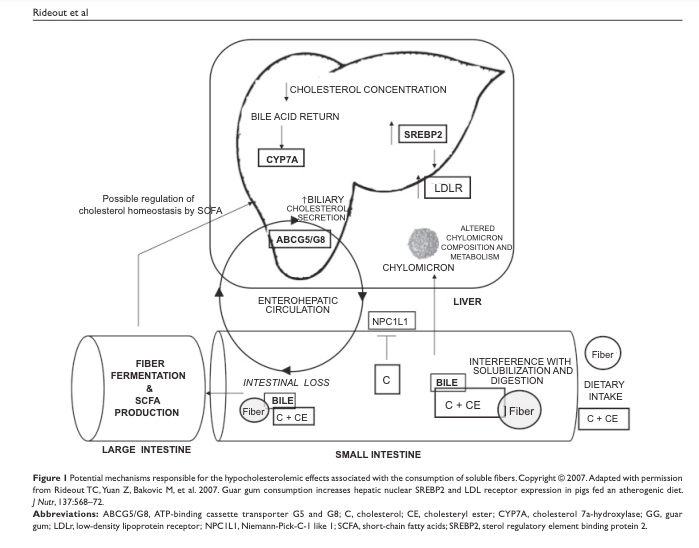Guar gum is the ground endosperm of the guar plant seeds (Cyamopsis tetragonalobus). It is estimated that commercial food-grade guar gum typically contains around 80% guaran, 5-6% crude protein, 8-15% moisture, 2.5% crude fiber, 0.5-0.8% ash, and small quantities of lipids consisting primarily of the fatty acids of plants. Guar gum is partly fermented by the intestinal microflora into short-chain fatty acids (SCFAs) during its transit through the large intestine. The rate of hydrolysis in humans is unclear, but guar gum's fermentation is likely to contribute to the production of SCFAs (Mortensen et al., 2017). Guar gum is chiefly used as a thickener and stabilizer in foods. It is a viscous fiber that slows gastric emptying and peristalsis, thus enhancing the gastrointestinal tract's anorexigenic and homeostatic signaling. A significant decrease in the formation of adiposity has been induced by preloading guar gum. The ingestion of guar gum causes an inhibitory effect on food intake, but over time this effect is lost (Hadri et al., 2015). Research shows that guar gum enhances satiety and diminishes the number of calories consumed during the day through snacking (Rao et al., 2015). Daily ingestion of 15 g of guar gum can result in significant weight loss in women (Tuomilehto et al., 1980).
The intake of 15 grams of guar gum results in lower overall serum cholesterol and low-density lipoprotein (LDL) cholesterol levels (Lalor et al., 1900). Guar gum consumption in mildly hypercholesterolemic insulin-dependent diabetic patients can improve glucose control and reduce serum LDL-cholesterol levels (Vuorinen-Markkola, Sinisalo, & Koivisto, 1992). For older female adults at risk of drops in postprandial blood pressure, guar gum consumption before a meal may be a beneficial therapy, according to a study by Jang, Hwang, and Kim (2015). The consumption of partially hydrolyzed guar gum in individuals with irritable bowel syndrome (IBS) can improve symptoms by reducing bloating and increasing stool frequency (Russo et al., 2015).
(Rideout et al., 2008)
References
Hadri, Z., Chaumontet, C., Fromentin, G., Even, P. C., Darcel, N., Bouras, A. D., Tomé, D., & Rasoamanana, R. (2015). Long term ingestion of a preload containing fructo-oligosaccharide or guar gum decreases fat mass but not food intake in mice. Physiology and Behavior, 147(2015), 198–204. https://doi.org/10.1016/j.physbeh.2015.04.039
Jang, A. L., Hwang, S. K., & Kim, D. U. (2015). Effects of guar gum ingestion on postprandial blood pressure in older adults. Journal of Nutrition, Health and Aging, 19(3), 299–304. https://doi.org/10.1007/s12603-015-0453-8
Lalor, B. C., Bhatnagar, D., Winocour, P. H., Ishola, M., Arrol, S., Brading, M., & Durrington, P. N. (1990). Placebo-controlled trial of the effects of guar gum and metformin on fasting blood glucose and serum lipids in obese, type 2 diabetic patients. Diabetic medicine : a journal of the British Diabetic Association, 7(3), 242–245. https://doi.org/10.1111/j.1464-5491.1990.tb01378.x
Mortensen, A., Aguilar, F., Crebelli, R., Di Domenico, A., Frutos, M. J., Galtier, P., Gott, D., Gundert‐Remy, U., Lambré , C., Leblanc, J., Lindtner, O., Moldeus, P., Mosesso, P., Oskarsson, A., Parent‐
Massin, D., Stankovic, I., Waalkens‐Berendsen, I., Woutersen, R. A., … Dusemund, B. (2017). Re‐evaluation of guar gum (E 412) as a food additive. EFSA Journal, 15(2). https://doi.org/10.2903/j.efsa.2017.4669
Rao, T. P., Hayakawa, M., Minami, T., Ishihara, N., Kapoor, M. P., Ohkubo, T., Juneja, L. R., & Wakabayashi, K. (2015). Post-meal perceivable satiety and subsequent energy intake with intake of partially hydrolysed guar gum. The British journal of nutrition, 113(9), 1489–1498. https://doi.org/10.1017/S0007114515000756
Rideout, T. C., Harding, S. V., Jones, P. J., & Fan, M. Z. (2008). Guar gum and similar soluble fibers in the regulation of cholesterol metabolism: current understandings and future research priorities. Vascular health and risk management, 4(5), 1023–1033. https://doi.org/10.2147/vhrm.s3512
Russo, L., Andreozzi, P., Zito, F. P., Vozzella, L., Savino, I. G., Sarnelli, G., & Cuomo, R. (2015). Partially hydrolyzed guar gum in the treatment of irritable bowel syndrome with constipation: effects of gender, age, and body mass index. Saudi journal of gastroenterology : official journal of the Saudi Gastroenterology Association, 21(2), 104–110. https://doi.org/10.4103/1319-3767.153835
Tuomilehto, J., Voutilainen, E., Huttunen, J., Vinni, S., & Homan, K. (1980). Effect of guar gum on body weight and serum lipids in hypercholesterolemic females. Acta medica Scandinavica, 208(1-2), 45–48. https://doi.org/10.1111/j.0954-6820.1980.tb01148.x
Vuorinen-Markkola, H., Sinisalo, M., & Koivisto, V. A. (1992). Guar gum in insulin-dependent diabetes: effects on glycemic control and serum lipoproteins. The American journal of clinical nutrition, 56(6), 1056–1060. https://doi.org/10.1093/ajcn/56.6.1056
*These statements are not meant to diagnose or treat. You should consult your health care provider before starting any new diet, exercise, or supplement.

